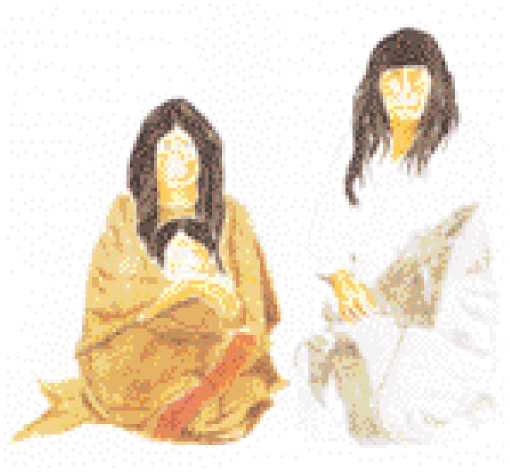The Bannock (pronounced BAN-uck) are considered an offshoot of the northern branch of the PAIUTE. Both peoples are part of the Uto-Aztecan language family, as are the UTE and SHOSHONE. Scholars classify these tribes as GREAT BASIN INDIANS. Great Basin Indians foraged and dug for anything edible—wild plants, rodents, reptiles, insects—in their harsh mountain and desert environment. They also had a staple food in common with the PLATEAU INDIANS to their north—the roots of the camas plant.
The nomadic Bannock occupied ancestral territory that has since become southeastern Idaho and western Wyoming. After they had acquired horses in the early 1700s, they ranged over a wider area into parts of Colorado, Utah, Montana, and Oregon. Their way of life came to resemble that of the PLAINS INDIANS, including buffalo-hunting and the use of tipis.
A mountain man by the name of Jim Bridger opened up trade relations with the Bannock in 1829. Yet in the following years, Bannock warriors preyed on migrants and miners traveling through their territory on the Oregon Trail. In 1869, after the Civil War, when more federal troops could be sent west to build new forts and to pacify militant bands, the government established the Fort Hall Reservation in present-day Idaho for the Bannock and northern branch of Shoshone.
The Bannock resisted reservation life. Their food rations on the reservation were meager, and tribal members continued to wander over a wide expanse of territory in search of the foods they had hunted and gathered for generations. As more and more whites settled in the region, they disrupted these traditional food staples of the Bannock; non-Indian hunters were killing the buffalo wholesale on the plains to the east. In addition, hogs belonging to white ranchers were destroying the camas plants near Fort Boise, Idaho. The Bannock, along with their neighbors, the Northern Paiute, revolted.
The Bannock War occurred in 1878. A Bannock warrior wounded two whites, who reported the incident to the army. Meanwhile, about 200 Bannock and Northern Paiute warriors gathered under a Bannock chief named Buffalo Horn. This war party clashed with a volunteer

Bannock parents with child
Patrol in June. When Buffalo Horn was killed, his followers headed westward into Oregon to regroup at Steens Mountain with Paiute from the Malheur Reservation. Two Paiute became the new leaders: a chief named Egan and a medicine man named Oytes.
Regular army troops rode out of Fort Boise in pursuit. They were under the command of General Oliver O. Howard, who had tracked down the NEZ PERCE during their uprising the year before. The soldiers caught up with the insurgents at Birch Creek on July 8 and dislodged them from steep bluffs. Warriors under Chief Egan tried to hide out on the Umatilla reservation. The Umatilla sided with the whites, however. They killed Egan and led soldiers to his men. Oytes managed to elude capture until August, but eventually turned himself in. A party of Bannock escaped eastward to Wyoming, but they were captured in September.
After the short-lived Bannock War, the Malheur Reservation was closed. The Paiute were settled among the YAKAMA on their reservation in the state of Washington. The Bannock were held prisoners at military posts for a time but were finally permitted to return to their reservation in Idaho.
That same year, 1878, another Indian war broke out in Idaho, known as the Sheepeater War. The Sheepeaters were Bannock and Shoshone who had migrated northward into the Salmon River Mountains of central Idaho and hunted mountain sheep as their main food. They too began raiding settlers crowding their homeland. There were not many of them, perhaps only 50, but they proved a stubborn enemy for the army in the rugged highlands. They routed one army patrol and eluded another. But the army wore them down with continuous tracking, and the Sheepeaters surrendered in October. They were placed on the Fort Hall Reservation in Idaho with their Bannock and Shoshone kin.
The Shoshone-Bannock Tribe of the Fort Hall Reservation, also referred to as the Sho-Bans, hold many traditional festivals every year, including a week-long celebration in August, several Sun Dances, and an all-Indian rodeo. They also maintain the Trading Post Complex, including a store known as the Clothes Horse, and offer high-stakes bingo. Starting in the 1990s, the Sho-Bans began a campaign to halt the air pollution emanating from an elemental phosphorous plant, which was a health hazard for the people of the Fort Hall Reservation. In 2001, the federal government forced the plant to spend $80 million in air improvement.




 World History
World History









